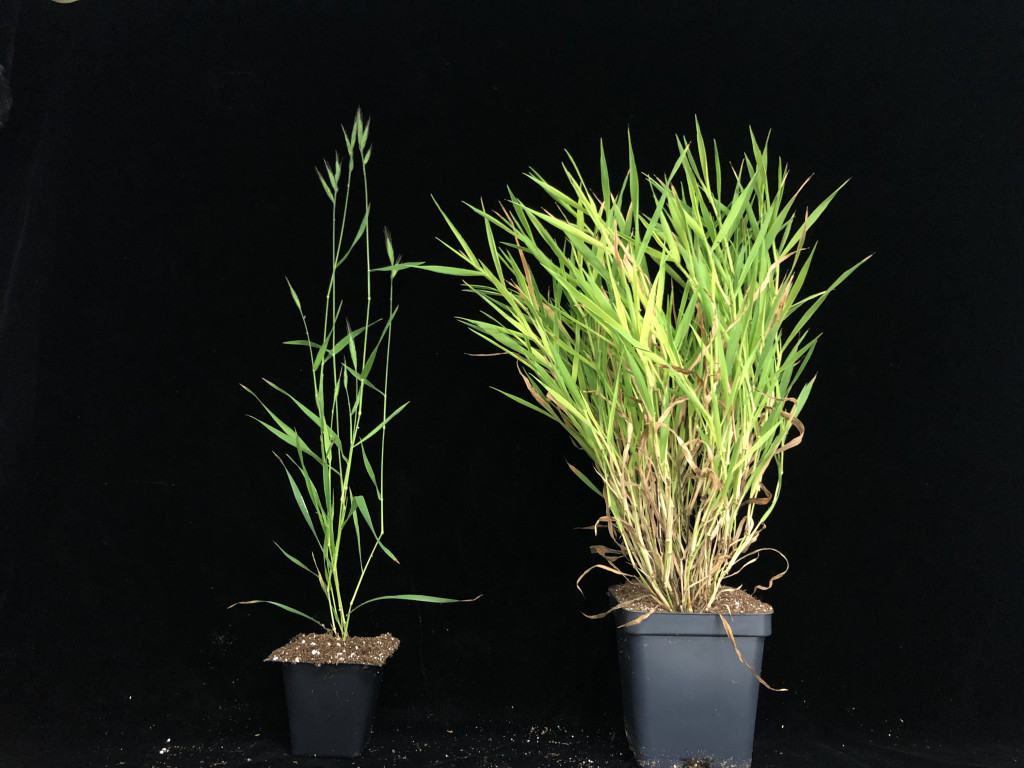New research offers insights into the biochemistry that makes grasses flower

Pictured here are two Brachypodium plants. Researchers at UW–Madison have identified a gene known as ID1 that helps to regulate the cascade of gene expression that leads to flowering. The plant on the left is flowering normally, thanks to the presence of ID1. In the plant on the right, a mutated ID1 gene has led to improper expression of downstream FT1 and FTL genes, resulting in a plant that continues to produce leaves instead of flowers.
Floral timing has major implications for agricultural crops because flowering is a key stage in their reproductive process. Biochemical pathways that lead to flowering have been extensively studied in the model organism Arabidopsis a plant in the mustard family. But little research exists on how these pathways differ in grasses – a distinct, agriculturally important family of plants. Now, new research by biochemists at the University of Wisconsin–Madison reveals a key component in the cascade of genes that regulate a key protein involved in grass’ flowering, offering insights into the onset of flowering in crops such as wheat, rye and barley.
What you need to know
Because they can’t uproot themselves and hunt for food, plants are exceptionally responsive to their environment, acquiring what they need to survive from their immediate surroundings. From sun, soil and rain, for example, plants access nutrients and water. Similarly, plants evolve mechanisms to make the most of their reproductive efforts by taking cues from their environment — flower too early and they risk frost damage; flower too late and the plant may miss the optimal growing season.
In many plants, the biochemical pathways that lead to flowering are triggered by specific daylengths (photoperiods) or exposure to the prolonged cold of winter (vernalization), ensuring that the onset of flowering coincides with appropriate environmental conditions. Some aspects of these pathways are similar across many families of plants. For example, all flowering plants require sufficient levels of a protein known as florigen to transition from the growth stage to the reproductive stage of their life cycle.
Regulation of the florigen family of genes involves a cascade of upstream genes turning on or off, creating a carefully orchestrated pathway that relies on environmental and biochemical cues. Arabidopsis thaliana, a member of the mustard family, has long been the standard model organism for studying plants, including flowering pathways.
But the genes responsible for regulating the onset of flowering differ across plant families. It is only since the early 2000s that plant researchers have worked with a model organism representative of temperate grasses: Brachypodium distachyon. As a result, little is known about the intricacies of florigen regulation in this plant family.
Why it matters
The timing of flowering can be essential to agricultural practices. Yields of important agricultural grasses such as wheat, rye and barley depend heavily on environmental factors such as day length and temperature. Efficient harvesting relies on synchronistic timing of flower production across a field.
For these reasons, floral timing is a key trait that scientists consider when breeding crops to optimize yield. Discoveries about the genes that control the timing of flowering can offer key clues to plant breeders aiming to develop crops that are well adapted to a given climate, which, in turn, can benefit farmers’ crop yields.
How our scientists made progress

Rick Amasino, a professor of biochemistry, leads the Amasino lab, where researchers study plant development and what makes plants flower.
Researchers in the Amasino Lab in the Department of Biochemistry have identified a gene responsible for regulating florigen genes in temperate grasses. Their findings, recently published in PNAS, reveal new insights into the biochemical pathway responsible for flower production.
A suite of florigen genes known as Flowering Locus T (FT) and FT-like (FTL) genes are common to many temperate grasses. The researchers used Brachypodium to investigate how an upstream gene specific to temperate grasses, Indeterminate1 (ID1), impacts expression of FT and FTL genes.
The presence of ID1 was required for several FT and FTL genes to be expressed, indicating that ID1 is involved in regulating these florigen-producing genes. Among other findings, the researchers demonstrated that mutations to the ID1 gene suppressed FTL gene expression, which would result in delayed flowering even when the plant is exposed to optimal environmental conditions.
These results identify the ID1 gene as a critical piece of the flower production pathway in temperate grasses. The research is a crucial step towards understanding how the genes responsible for flowering in grasses such as Brachypodium differ from the pathways scientists have discovered in Arabidopsis.
Check out more in the Department of Biochemistry’s series Research in Brief: The What, Why, and How of new research exploring the world around us — and inside us.
This research was funded in part by the U.S. National Science Foundation (IOS-1755224), the Great Lakes Bioenergy Research Center, the U.S. Department of Energy, Office of Science, Office of Biological and Environmental Research (DE-SC0018409), and the College of Agricultural and Life Sciences and the Office of the Vice Chancellor for Research and Graduate Education of the University of Wisconsin–Madison.



